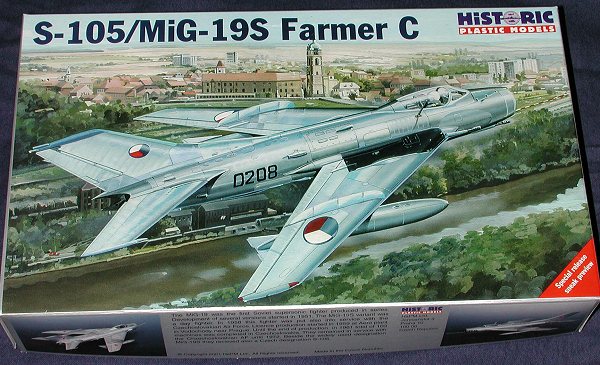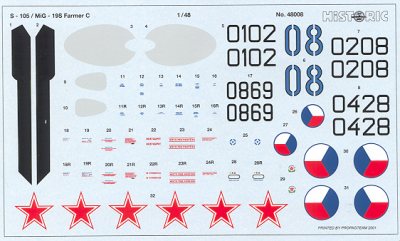
|
KIT: |
Historic Plastic Models (HiPM) 1/48 Mig-19S |
|
KIT # |
48-008 |
|
PRICE: |
$39.95 MSRP |
|
DECALS: |
Five aircraft |
|
REVIEW & |
|
|
NOTES: |
Short run with etched fret; injected canopy |

|
HISTORY |
In the early 1950s, MiG could do no wrong. After a pair of very successful transonic fighters, specifically the MiG-15 and 17, it was discovered that more was needed in order to make a truly supersonic jet. That more was power. The prototype MiG-19 called the SM-2, first flew in mid-1952 and was powered by two afterburning turbojets. This is what was needed to make a plane capable of breaking the sound barrier in a straight line.
Like the F-86 and F-100, it had an all flying tail, an item needed when the plane reached supersonic speeds. Unfortunately, using two engines to achieve the speed needed meant that the MiG-19 was a major gas hog. Even with auxiliary fuel tanks and lower speeds, the range was under 1400km. Once the burners were lit, that dropped dramatically.
As with the Mig-15, the MiG-19 was license built in Czechoslovakia by Aero and the first S-105 took to the skies in late 1959. The aircraft was also built in China and modified versions of it are still in use by a number of air arms throughout the world.
|
THE KIT |

Mention 'HiPM' to anyone who has actually built one of their previous kits and you'll have to calmly talk them out of the fetal position. Actually, they aren't that bad, but they aren't that good, either. Perhaps this one will be different. Let's take a look at the bits and pieces.
First thing you see when you open the box is that the parts are kept in industrial strength bags. This is good. It keeps pieces from falling out of the bag. The decals, clear bits (injected, too), and etched metal fret are in a separate bag. The usual darkish grey plastic is very smooth and detail is very fine etched lines. Actually, they may be too fine as I can see many being sanded off during construction if this one is typical of previous kits.
I always look for sink marks and ejector pin marks. Sadly, I found both of them. Any thick plastic part had rather deep ones. This was most obvious on the aft section of the fuselage, the exhaust cone, and several interior parts. They could also be found on the gear doors, as those are a bit thick. Ejector pin marks were found on interior parts and won't be easy to remove in some cases. There was very little flash.
For optional bits, you have a pair of canopies for open or closed positions, optional fuel tank sizes, the speed brakes can be positioned open or closed (though you will have to make the actuating pistons), two different fins, and optional radio antennas. The photo-etch is mostly for the interior, though there are compressor facings and one of the antenna options in metal. You also have to make the exhaust pipes out of plastic card. I mean really!! For $40 retail, you'd think those would be provided!
I found some of the construction steps a bit odd. For one thing, you install the cockpit sidewalls AFTER the floor and fuselage halves are glued together! You stick them in through the cockpit opening. Is this a tail heavy kit? You bet! The instructions recommend a minimum of 50 grams of nose weight. You'll have fun installing the myriad of intake scoops along the back of the fuselage. I was sorta hoping those would be molded in place, but I guess not.
 One place that HiPM....oops,
Historic Plastic Models has always excelled is the instruction sheet. This one
is a 32 page booklet complete with detailed instruction steps, painting
information and decal placement. The only place it falls down is in color
information. All is generic with no FS and no paint matchups. However, since
your basic overall color options are bare metal, this isn't that much of a
problem. You can do five aircraft; one Soviet and four Czech. I'm sure the
aftermarket folks are feverishly working away at options for this kit. HiPM
itself has a Shengyang J-6 listed for future release in May with the optional
parts to do that variant. The decals themselves look very nice. Those I used on
the P-51H worked quite well and I was pleased with them These should be no
different. They even include the wing walk areas and the blast areas around the
wing root cannon.
One place that HiPM....oops,
Historic Plastic Models has always excelled is the instruction sheet. This one
is a 32 page booklet complete with detailed instruction steps, painting
information and decal placement. The only place it falls down is in color
information. All is generic with no FS and no paint matchups. However, since
your basic overall color options are bare metal, this isn't that much of a
problem. You can do five aircraft; one Soviet and four Czech. I'm sure the
aftermarket folks are feverishly working away at options for this kit. HiPM
itself has a Shengyang J-6 listed for future release in May with the optional
parts to do that variant. The decals themselves look very nice. Those I used on
the P-51H worked quite well and I was pleased with them These should be no
different. They even include the wing walk areas and the blast areas around the
wing root cannon.
|
CONCLUSIONS |
Well, it is a 1/48 MiG-19 that actually looks like a MiG-19 and not some sort of mutant as did the AA kit. I seriously doubt if you'll find this kit from any other manufacturer in this scale for a long time. I can pretty well guarantee that it will take work and allow you to use many of those modeling skills you have developed over the years!
Review kit courtesy of my kit collection.
If you would like your product reviewed fairly and quickly by a site that has over 100,000 visitors a month, please contact me or see other details in the Note to Contributors.